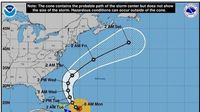Hurricane Erin, the first Atlantic hurricane of 2025, has become a powerful and unpredictable force over the past several days, cycling between weakening and strengthening as it barrels through the Caribbean and threatens the U.S. East Coast with dangerous surf, winds, and flooding. As of early Monday, August 18, Erin had intensified once again, reaching Category 4 status with sustained winds of 130 mph (215 kph), according to the U.S. National Hurricane Center in Miami.
The storm's journey has been marked by dramatic fluctuations in strength. Erin first achieved the exceedingly dangerous Category 5 status on Saturday, August 16, with maximum winds of 160 mph (260 kph), before weakening to Category 3 by Sunday. However, forecasters warned that Erin was rapidly growing in size and would likely regain strength, a prediction that materialized as the storm reintensified to Category 4 by Monday morning.
As Erin churned northwest at 13 mph, its outer bands began pelting the Turks and Caicos Islands and the southeast Bahamas with rain and wind. By 5 a.m. Monday, the hurricane was located about 105 miles north-northeast of Grand Turk Island and 915 miles south-southeast of Cape Hatteras, North Carolina. The Bahamas government issued a tropical storm watch for the central Bahamas, while warnings remained in effect for the Turks and Caicos and southeast Bahamas, the National Hurricane Center reported.
Puerto Rico and the U.S. Virgin Islands were among the first to feel Erin’s wrath as the hurricane’s outer bands brought heavy rains and tropical-storm-force winds on Sunday. According to Luma Energy, which oversees power transmission in Puerto Rico, more than 147,000 utility customers lost electricity at the height of the storm. By 5:30 a.m. Monday, 96.3% of customers had service restored, with most remaining outages concentrated in Caguas, Mayagüez, and San Juan. The storm also forced the cancellation of over 20 flights in Puerto Rico and the Caribbean, though the U.S. Coast Guard allowed all ports in Puerto Rico and the U.S. Virgin Islands to reopen as winds and rains eased late Sunday.
Despite the fluctuating intensity, Erin’s ever-expanding size has alarmed forecasters. Hurricane-force winds extended up to 60 miles from the center, with tropical-storm-force winds reaching outward as far as 230 miles. Swells from Erin were expected to affect the Virgin Islands, Puerto Rico, Haiti, the Dominican Republic, and the Turks and Caicos Islands over the following days, raising the risk of flash and urban flooding, particularly in low-lying areas.
While Erin is not expected to make direct landfall on the U.S. mainland, its impact will be felt up and down the East Coast. The storm is forecast to pass east of the southeastern Bahamas and move between Bermuda and the U.S. East Coast by midweek. Dangerous surf and life-threatening rip currents are expected to batter the beaches of the U.S., Bermuda, and Atlantic Canada for several days, with tropical storm-force winds likely reaching Delaware by August 20, according to federal forecasters quoted by local media.
Communities along the U.S. East Coast, particularly in North Carolina, have been placed on high alert. Dare and Hyde counties declared states of emergency and issued mandatory evacuation orders for parts of the Outer Banks, including Ocracoke and Hatteras islands. The Outer Banks, a string of barrier islands renowned for their scenic beauty, now face the threat of major flooding and erosion. Officials fear that several days of heavy surf, high winds, and relentless waves could wash out portions of North Carolina State Highway 12, the main artery connecting the islands. "You're dealing with a major hurricane. The intensity is fluctuating. It's a dangerous hurricane in any event," Richard Pasch of the National Hurricane Center told the press.
Despite these warnings, the mood on Hatteras Island remained oddly calm as evacuation orders went into effect. Angela Tawes, a local business owner, observed, "It's so beautiful outside. It's hard for people to feel like there's a hurricane coming when it's so gorgeous." Yet, officials and meteorologists continue to urge caution, warning that rough ocean conditions and strong winds could arrive with little warning, and that the barrier islands are especially vulnerable to flooding and road washouts.
Federal forecasters and the National Weather Service have underscored the risks posed by rip currents, which are expected to be widespread and dangerous as Erin’s swells reach the coast. According to the National Oceanic and Atmospheric Administration (NOAA), rip currents are narrow, fast-moving channels of water that flow away from the shore, capable of sweeping even experienced swimmers out to sea. The United States Lifesaving Association advises swimmers caught in a rip current to remain calm, avoid swimming directly against the current, and attempt to escape by swimming parallel to the shoreline or toward breaking waves, then at an angle back to the beach. If unable to reach shore, swimmers are urged to float, tread water, and signal for assistance.
Erin’s development and rapid intensification have reignited discussions about the role of climate change in shaping hurricane behavior. Scientists cited by multiple outlets, including the Associated Press and The Guardian, have linked the increasing frequency of rapidly intensifying hurricanes in the Atlantic to global warming. As the atmosphere holds more water vapor and ocean temperatures rise, hurricanes are able to unleash more rain and strengthen more quickly. Warmer waters serve as fuel for these storms, making them larger and more unpredictable. “Global warming is causing the atmosphere to hold more water vapor and is raising ocean temperatures, and warmer waters enable hurricanes to unleash more rain and strengthen more quickly,” The Guardian reported, echoing a growing consensus among climate scientists.
For residents and visitors along the Atlantic coast, the message from officials is clear: stay alert, heed evacuation orders, and monitor updates from trusted sources. Hurricane season, which runs from June 1 through November 30, is far from over, and Erin’s unpredictable path serves as a stark reminder of the power of nature—and the increasing volatility of the world’s oceans.
As Hurricane Erin continues its trek north, communities from the Caribbean to Canada’s Atlantic coast are bracing for its effects. Whether it’s the threat of power outages, flight cancellations, road washouts, or life-threatening surf, the storm’s legacy will be felt long after the winds die down and the skies clear.

